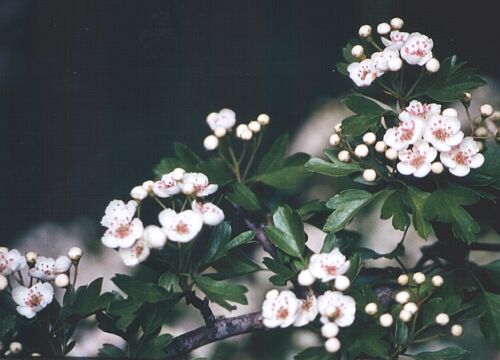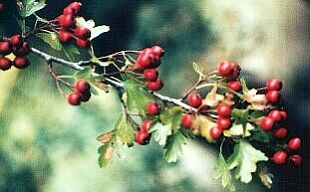 |
|||
|
|
|||
|
Chaucer There is definitely magic in the air when the Hawthorn trees are in blossom. They are an introduced species in Australia, and reportedly are often treated as a noxious weed. I find this sad, despite environmentalist leanings, considering their general usefulness and the reverence with which they are held in the British Isles. They seem very much at home in the localities in which they have naturalised, such as Victoriaís Central Highlands, and are usually found on land already well domesticated, so I canít see the harm in them. Once you start looking for them, they seem to be everywhere - as hedges, in groves, on hillsides, occasionally by a spring or a creek, sometimes as single trees near where old farmhouses used to be. There are even a couple right in the heart of my hometown, on the doorstep of the Centrelink office, a rather incongruous place to find them! A few years ago, the ornamental crabapple at my motherís house suddenly and inexplicably sprouted a Hawthorn from below the graft. Itís already taller than the crabapple, which is nearly 30 years old. No wonder people also call it Quickthorn. Iíve since discovered that Hawthorn is a commonly used rootstock for fruit trees such as crabapple, medlar and pear. My favourite Hawthorns are in a grove in the Central Highlands, and I visit them at different seasons to observe their annual cycles and photograph them. In the early spring, the shiny new leaves are just starting to sprout again after the winter. Each year, I eagerly await the Hawthornís flowering, checking for the first appearance of the buds, tiny white balls tinged with green which herald the unfurling of the richly scented five-petalled blossoms. The symbolism of the Hawthorn tree and the seasonal festival of Beltane are inextricably entwined. Hawthorn is also known by its country names of Whitethorn, Mayblossom or May, which correlates with its time of blooming in the Northern hemisphere (usually October-November in the Southern hemisphere). In the mild maritime climate where I live, some varieties of Hawthorn have occasionally been known to flower as early as Spring Equinox, a full six weeks before Beltane. Further inland, in the mountains, many trees still might not be in full bloom by the ďcorrectĒ date, depending on the vagaries of the season. To me, this seems like a good reason to vary the date of Beltane celebrations slightly according to location, climate and season, even the phase of the moon, rather than having it at exactly the same time each year as is the modern custom. However, having a Spring Equinox and Beltane celebration one on top of the other would seem a bit odd, Hawthorn blossom notwithstanding, because Spring weather can be quite erratic and probably wonít feel anything like Summer until at least Beltane. Hawthorn is a favourite for garlands and decoration at Beltane, along with other greenery, such as young oak leaves and other flowers. It is also used to decorate maypoles. The scent is very heady and sensuous, and has been associated with female sexuality and fertility, which is logical, given some of the traditional symbolism of Beltane! Hawthorn petals bear a remarkable resemblance to confetti, as anyone who has ever looked at the ground under a blossom-laden Hawthorn will attest. Quite possibly this is one of the origins of the modern custom of sprinkling confetti at weddings. However, paper confetti is a very poor substitute for fragrant blossoms with magical associations. As churches and wedding venues nowadays ban confetti because of the ugly mess it makes, this seems like an excellent excuse to revert to the old ways. Sprinkling blossoms and flower petals over handfasted couples is a much more romantic custom. If Hawthorn is not in season, apple blossom, jasmine or rose petals can be used, or a combination of any of these. I collect and dry Hawthorn blossom annually to use in incense blends or in teas, and also to remind me of Beltane until the following season when the trees are adorned again. I like to lie in the grass under the blossom-laden trees in the late spring, and drink in that haunting and wonderfully erotic scent. I donít suppose the fate of Thomas the Rhymer (who was spirited off by the Queen of Elfland) is likely to befall me, being a woman. All the same, itís probably best not to fall asleep, just in case another denizen of Faerie might decide to whisk me away! Sadly, the blossoms donít last very long, and are soon fluttering to the ground. After the petals drop, each fertilised flower swells and has grown by early Summer into a hard green berry. By Autumn Equinox, the haws or berries are a shiny red and hang in tantalising clusters - I enjoy eating them, although this probably has more to do with the fun of collecting and eating wild foods than how they taste in their raw state. They are reported to be excellent when made into ketchups, jellies and wine, but the ones I collect never make it that far. By Samhain, the fruit has usually gone, polished off by birds or fallen to the ground, and the leaves are yellowing and have started to drop. In Winter, the trees stand silhouetted against the horizon with their gnarled and twisted branches, tufted with lichen. I have no doubts about why they are known as Faerie trees. Each is amazingly different in shape to its neighbours and has a distinctive individual character. I can almost see the ghostly fingers of the Hawthorn devas reaching out on a moonlit winter night to caress the face of an unsuspecting passer-by. In Celtic myth and folklore, Hawthorn trees are frequently associated with springs and holy wells as guardians and also as gateways to the Otherworld. Their sharp spines no doubt symbolise their protective functions. Thomas of Ercledoune, the hero of the traditional Scottish ballad Thomas the Rhymer, is reported to have received his initiation under a Hawthorn Tree, and spent seven years in the Realm of Faerie as a result. Hawthorn forms an integral part of Christian as well as Pagan lore. One of the most famous varieties of Hawthorn is the Winter flowering Glastonbury thorn, said to have blossomed from the staff of Joseph of Arimathea when he rested at Wearyall Hill. In the Middle East, there is another variety which as legend has it, was used for Christís crown of thorns. There are somewhere in the vicinity of 1,000 varieties worldwide, but most people are familiar with English Hawthorn and Common Hawthorn. Some herbalists say that English Hawthorn is Crataegus oxyacantha, and others refer to Common Hawthorn by this name. Iím not yet convinced that the two are merely the same thing, as Jacqueline Memory Paterson says English Hawthorn has pink-red or pink tinged blossoms and 2 or 3 seeds per berry, and Common Hawthorn has white blossoms and one seed per berry. Iíve only recently discovered for myself that some trees have berries with only one seed, but havenít established to my own satisfaction which variety this is. To confuse matters even further, white Hawthorn frequently turns pink as the blossoms age. So the mystery remains for the time being, but may have something to do with the ease with which the species hybridize. Western herbal medicine uses both C. oxyacantha and C. monogyna. The leaves or blossoms in a poultice have a reputation in first aid for drawing splinters. The blossoms are one of the most popular cardiac tonics in modern herbal medicine, used for palpitations, angina and hypertension. Hawthorn is also reported to have sedative, diuretic and astringent properties, and has been used to treat insomnia, diarrhoea, kidney disorders and excessive menstruation. Oriental medicine uses the berries of C. pinnatifida, mainly as a digestive stimulant and to clear stagnation. Hawthorn is considered fairly safe, but consult a herbalist or a reputable herbal for correct doses and usage. Hawthorn is also part of the FES Quintessentials range of flower essences, produced in California. It has been recommended in flower essence therapy for cancerous conditions, heart disease and for the emotional states such as extreme stress and grief which may have a bearing on the subsequent development of cancer. I have sometimes used the flower essence to add some extra oomph to incense or magical blends containing Hawthorn blossoms, or where the correspondences are appropriate.

Beltane Punch (alcohol-free)
I created both of these recipes for Beltane 1995, using mineral water straight from the springs at Hepburn, and freshly collected leaves and blossoms from local trees.
Grind ingredients in mortar and pestle. If each ingredient is partially crushed before adding the next, it is easier to mix. If the mixture ends up too dry, a few drops of a compatible essential oil (such as Rose) can be added. If giving as a gift, an incense mixture always looks more attractive if not completely powdered. It can be crushed more finely immediately before use if desired. Store in glass jars or sealed cellophane packets. Burn on charcoal blocks.
REFERENCES Ah Ket,
Gregory Herbal Treatments for Common Ailments Cunningham,
Scott The Complete Book of Incense, Oils & Brews Grieve,
Mrs M. A Modern Herbal Gurudas
Flower Essences and Vibrational Healing Hutton,
Ronald Stations of the Sun Ody, Penelope
The Complete Medicinal Herbal Paterson,
Jacqueline Memory Tree Wisdom Richardson,
Rosamund Hedgerow Cookery Stewart,
R.J. The UnderWorld Initiation |
|||
|
Copyright Shadowplay 2001. All rights reserved. WebDesign: Rhea - Page last updated January 2001 |
|||

